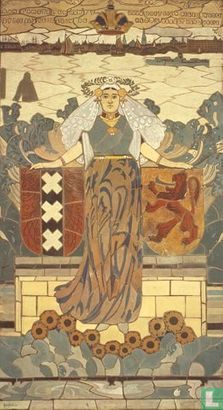Catalogue information
The Virgin of Amsterdam 1900 Adolf le Comte, The Virgin of Amsterdam, 1900 "The Virgin of Amsterdam" was one of the four section tile tableaux that were submitted to the World Exhibition, where new developments and gadgets were presented worldwide. Adolf le Comte (1850 Geestbrug - 1921 The Hague) NV Koninklijke Delftse Pottery Factory De Porceleyne Fles, 'The Virgin of Amsterdam', 1900, pottery, height: 273.0 x width: 150.0, AA2004, purchased at Mak van Waay auction in 1978. On loan to the Drents Museum in Assen. The sectional technique was also new. Characteristic are the joint joints, which follow the main lines of the drawing, such as with stained glass. This results in irregular tile fragments, avoiding the disruptive effect of the square tile pattern. The matt tile fragments of the "Virgin of Amsterdam" are made of hard-baked layers of porcelain without glaze. The production of the matt section was difficult, because drying and baking shrinkage of the top layer and substrate had to be matched to each other and the tile fragments were not allowed to warp or crack. In the center of the tableau is a young woman, the Virgin of Amsterdam, with open arms and in Dutch traditional costume. She is standing in front of a low wall with sunflowers at her feet. With her right hand she leans on a shield with the Amsterdam coat of arms and with her left hand on a shield with the Dutch lion. A flower garland adorns her head. In the background is Amsterdam as a port city on the IJ. Sailing ships, but also a steamboat, sail on the water. The station building with the round roof is located at the harbor. The stylistic features of the Jugendstil can be recognized in the ripples of the water and in the robes of the virgin. The new shapes and colors of the section tile panel received international recognition at the world exhibition and were awarded a gold medal. The technique was subsequently used only to a limited extent and soon fell completely out of use. Today the tableau is not only characteristic of the industrial revolution at the beginning of the twentieth century because of its technique, but also because of its images. Inventory number AA2004 Title The Virgin of Amsterdam Manufacturer (s) Porceleyne Fles, De; Comte, A. le Manufacture date 1900 Description Description De virgin van Amsterdam Height / Width / Diameter 273/150 / Keyword (s) ceramic, tile Material (s) earthenware, stoneware Manufacturer's role role:, Verv. name: Comte, A. lerol: w, Verv. name: Porceleyne Fles, The Manufacture Period Place of manufacture Delft Catalog number Location Drents Museum, ASSEN Source: http://www.cultureelerfgoed.nl/
This text has been translated automatically from Dutch
Click here for the original text

